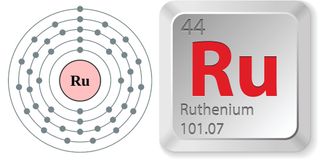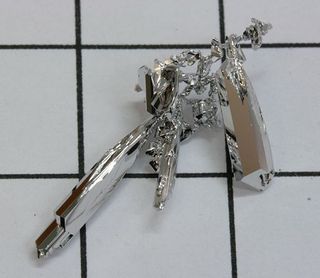Facts About Ruthenium

Word origin: The word ruthenium comes from Ruthenia, the Latin word for Russia.
Discovery: Ruthenium’s discovery is generally credited to Karl Ernst Klaus in 1844. Nearly 20 years before, however, Jöns Berzelius and Gottfried Osann stumbled upon its impure form. In 1827, they were examining residues left after dissolving crude platinum from Russia’s Ural Mountains in aqua regia. As they worked, Osann thought he came upon three new metals. He called one of them ruthenium. In 1844, Klaus demonstrated that Osann’s ruthenium oxide was very impure and that the new metal was contained in the oxide. From the portion of crude platinum that is insoluble in aqua regia, Klaus obtained 6 grams of ruthenium.
Properties of ruthenium
Ruthenium is a member of the platinum group. It is a hard, white transition metal. It does not tarnish at room temperatures but oxidizes explosively. It can be attacked by halogens and hydroxides. It has four crystal modifications. It can be plated by electrodeposition or thermal decomposition methods. [See Periodic Table of the Elements]

It is a powerful alloying agent, versatile catalyst, and improves corrosion resistance.
Scientists have found at least eight oxidation states, but of these +2, +3, and +4 are the most common. Ruthenium tetroxide is highly toxic and may explode. Ruthenium compounds appear to be very similar to those of cadmium.
Sources of ruthenium
Like other members of the platinum group, ruthenium occurs natively in mineral deposits in the Ural Mountains and in North and South America. It is also found in the pyroxinite deposits South Africa.
To be isolated for commercial use, it must be produced through a complex chemical process. The final stage involves the hydrogen reduction of ammonium ruthenium chloride, yielding a powder. The powder is then consolidated.
Uses of ruthenium
Adding ruthenium is one of the most effective ways to harden platinum and palladium. It is alloyed with these metals to make electrical conducts that are extremely wear resistant. A ruthenium-molybdenum alloy is said to be superconductive at 10.6 K (-440.6 F / -262.5 C). The corrosion resistance of titanium is improved a hundredfold by addition of 0.1 percent ruthenium.
Ruthenium is a versatile catalyst. It can be the catalyst to split hydrogen sulfide (H2S) through light, using an aqueous suspension of cadmium sulfide (CdS) particles loaded with ruthenium dioxide. This ability could help to remove of H2S from oil refining and other industrial processes.
(Source: Los Alamos National Laboratory)
Sign up for the Live Science daily newsletter now
Get the world’s most fascinating discoveries delivered straight to your inbox.

